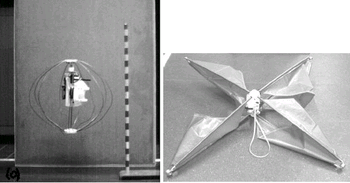July 6, 2007 feature
Jumping robots take clues from nature

A group of mechanical engineers from the University of Bath has a peculiar interest in flying squirrels, fleas, and grasshoppers. Inspired by animals considered to be excellent jumpers, the researchers have designed two jumping robots, one of which demonstrated some of the highest jumps for an autonomously powered robot so far engineered.
Rhodri Armour et al. introduced the two robots, Jollbot and Glumper, in a recent issue of Bioinspiration & Biomimetics. Jumping robots could provide solutions to traveling across rough terrain, such as climbing stairs and jumping fences, that normally create obstacles for wheeled robots and walking robots. The researchers hope that Jollbot and Glumper, with their biologically inspired mechanisms, will serve as prototypes for future generations of space robots.
“The cost per kilogram of launching something into space is very large, so jumping robots, which are likely to be light in weight to maximize their own performance, are ideally suited from that perspective,” Armour told PhysOrg.com. “On any planetary body with lower than earth gravity, a device which jumps would travel higher and therefore further for each jump.”
Armour explained that other advantages of jumping robots include a higher damage tolerance, the ability to survive a rough landing, and a low cost, which enables semi-sacrificial missions.
“For earth-bound uses, there are a variety of other possible applications that involve locomotion over random or rough terrain,” he added. “Typically these would involve exploration and could occur in places such as volcanoes, caverns, mountainous regions, or more structured rough environments such as urban areas with stairs and other obstacles. Other applications could be for entertainment, such as tourist guides.”
Jollbot (which gets its name from its combined jumping and rolling motion) has a skeletal structure made of semi-circular hoop springs. The central axis is equipped with a battery pack, servos and a radio receiver. When compressed, the springs hold energy that, when released in an instant, provide lift to the robot for a height of about 0.18 meters, which is about 2/3 its height.
While an unusual shape, Jollbot’s design requirements closely follow a variety of biological counterparts. Jollbot can store energy, just as fleas, leafhoppers, dogs, and humans store energy in rubber-like biological materials.
Also, Jollbot has a catch mechanism that ensures it will remain ready to jump without requiring additional energy. Similarly, grasshoppers’ and locusts’ specialized “metathoracic” jumping legs can remain in a flexed position by a tendon hooked around a cuticle for a natural catch mechanism, like a catapult. Armour et al. present information on many more biological examples in addition to these.
“Evolution has allowed natural systems to find optimal approaches to their specific combination of requirements, and so designers can look to nature when faced with similar challenges in engineering,” Armour explained. “It is, however, critical that the biological inspiration is taken at the appropriate level, copying intelligently rather than directly to allow for any additional interacting elements that are not relevant to the other system. General principles should be adopted, such as the rapid release of slow-stored energy and maximizing leg length.”
Glumper (named for being a glider and jumper) performed even better than Jollbot. Glumper’s four long “legs” each have a spring “knee,” and thin membranes attached to the legs serve as wings which the robot can use to glide after jumping. Somewhat similar to Jollbot, Glumper winds itself in until released by a clutch which causes the robot to jump. A control box with two battery-powered motors is arranged on the central cord.
Glumper, at 0.5 meters tall, can clear a height of 1.17 meters, and a distance of 2 meters. The researchers hope that, in the future, lightweight solar panels might power the compression mechanism instead of the batteries, which could greatly increase its operational range.
Like Jollbot, Glumper also had biological inspiration, with its wings derived from the membranes (or “patagia”) of the flying squirrel, as well as the controlled air braking in this animal and the flying fish. Compared with the scientists’ list of requirements for these biologically inspired robots, Glumper and Jollbot satisfy several, although their power density could be improved through increasing power, decreasing mass, or decreasing time of action.
“For an autonomous exploration robot/rover to be successful in its chosen application, it needs to have energy autonomy and to be completely reliable,” Armour said. “For complete unassisted autonomy, the recovery of energy from a robot’s operating environment is required, and this is probably the most difficult challenge for any mechanical engineer.”
But while Glumper’s jumps have landed it between the domestic cat and the antelope in terms of power per unit weight, the flea will likely remain difficult to match, with its ability to jump more than 100 times its body length.
“When taking biological inspiration, the effect of scaling should always be considered,” Armour said. “Fleas have renowned jumping ability, but it is unlikely that they could jump at all if scaled to the dimensions of Jollbot or Glumper.”
Citation: Armour, Rhodri, Paskins, Keith, Bowyer, Adrian, Vincent, Julian, and Megill, William. “Jumping robots: a biomimetic solution to locomotion across rough terrain.” Bioinsp. Biomim. 2 (2007) S65-S82.
Copyright 2007 PhysOrg.com.
All rights reserved. This material may not be published, broadcast, rewritten or redistributed in whole or part without the express written permission of PhysOrg.com.





















